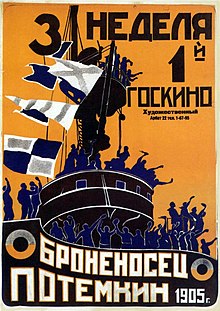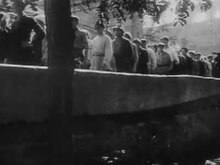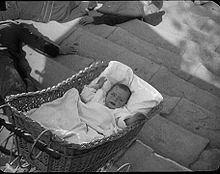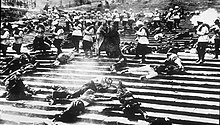Battleship Potemkin
From Wikipedia, the free encyclopedia
For the real-life battleship, see Russian battleship Potemkin.
For the Pet Shop Boys album, see Battleship Potemkin (album).
| Battleship Potemkin | |
|---|---|
 | |
| Directed by | Sergei Eisenstein |
| Produced by | Jacob Bliokh |
| Written by | Nina Agadzhanova Nikolai Aseyev Sergei Eisenstein Sergei Tretyakov |
| Cinematography | Eduard Tisse |
| Distributed by | Goskino |
| Release dates | 21 December 1925 (USSR) December 5, 1926 (USA;NYC only) |
| Running time | 75 minutes |
| Country | Soviet Union |
| Language | Silent film Russian intertitles |
Battleship Potemkin (Russian: Броненосец «Потемкин», Bronenosets Po'tyomkin), sometimes rendered as Battleship Potyomkin, is a 1925 silent film directed by Sergei Eisenstein and produced by Mosfilm. It presents a dramatized version of the mutiny that occurred in 1905 when the crew of the Russian battleship Potemkin rebelled against their officers of the Tsarist regime.
Battleship Potemkin has been called one of the most influential propaganda films of all time,[1] and was named the greatest film of all time at the Brussels World's Fair in 1958.[2][3][4]
Contents
[hide]Plot[edit]
The film is set in June 1905; the protagonists of the film are the members of the crew of the Potemkin, a battleship of the Imperial Russian Navy's Black Sea Fleet. Eisenstein divided the plot into five acts, each with its own title:
Act I: Men and worms[edit]
The Potemkin is anchored off the island of Tendra. When deploying a food ration sailors realize that the meat for the crew is infested with insect larvae. Led by the brave Grigory Vakulinčuk (Aleksandr Antonov), the sailors protest and demand rations of healthy food. In response the authorities call upon the ship's doctor. The doctor claims that the meat is good and perfectly edible and the crew is ordered to eat it without making a fuss. The crew refuses to accept this and the commanders threaten to shoot anyone who refuses to eat the meat. Some of them agree to eat the meat, but others refuse and are grouped together on the deck of the ship under a tarp in front of the firing squad waiting to be shot as a warning to all those who dare to even imagine an insubordination.
Act II: Drama on the deck[edit]
All those who refuse the meat are judged guilty of insubordination and instantly brought to the edge of the bridge where they receive religious rites reserved for death row inmates. In front of the firing squad none of them show remorse, convinced that what they are doing is right. The captain gave the order to open fire but, the soldiers in the firing squad lower their guns and the uprising begins. The sailors are poorly armed but outnumber the officers, which allows them to also take control of the ship. The officers are killed and the doctor is thrown into the water.
Act III: The dead man called[edit]
The mutiny is successful but many of the sailors are killed in battle, including Vakulinčuk, the charismatic leader of the rebels who took possession of the ship. The Potemkin arrives at the port of Odessa. Vakulincuk's body is taken ashore and displayed publicly by his companions in a tent with a sign on his chest that says "Dead for a spoonful of soup." The sailors gather to make a final farewell and praise Vakulinčuk as a hero. The people of Odessa welcome the sailors, but they attract the attention of the Tsarist police.
Act IV: The Odessa steps[edit]
The Cossacks of the Tsar arrive at Odessa in retaliation and march toward the unarmed crowd with their rifles. The people run away, but the Cossacks shoot men, women, and defenseless children. The scene has become famous: the soldiers are only shown through details that make them impersonal, inflexible (the boots marching and stomping the victims, the guns that shoot), while the people of Odessa fall in extremely violent ways. The soldiers show no sign of wanting to stop the massacre. The sailors of the Potemkin then decided to shoot at them with the guns of the battleship. Meanwhile, the news that a fleet of ships in the harbor of the Tsar is coming to quell the revolt of Potemkin.
Act V: One against all[edit]
The sailors of the Potemkin decide to go all the way and lead the battleship from the port of Odessa to face the fleet of the Tsar. Just when the battle seems inevitable, the sailors of the Tsarist ships incredibly refuse to open fire on their comrades, externalizing with songs and shouts of joy their solidarity with the mutineers and allowing them to pass unmolested through the fleet, waving the red flag.
Cast[edit]
- Aleksandr Antonov — Grigory Vakulinchuk (Bolshevik sailor)
- Vladimir Barsky — Commander Golikov
- Grigori Aleksandrov — Chief Officer Giliarovsky
- Ivan Bobrov — Young sailor flogged while sleeping (as I. Bobrov)
- Mikhail Gomorov — Militant sailor
- Aleksandr Levshin — Petty Officer
- N. Poltavseva — Woman with pince-nez
- Konstantin Feldman — Student agitator
- Beatrice Vitoldi — Woman with the baby carriage
Film style and content[edit]
The film is composed of five episodes:
- "Men and Maggots" (Люди и черви), in which the sailors protest at having to eat rotten meat;
- "Drama on the Deck" (Драма на тендре), in which the sailors mutiny and their leader, Vakulinchuk, is killed;
- "A Dead Man Calls for Justice" (Мёртвый взывает) in which Vakulinchuk's body is mourned over by the people of Odessa;
- "The Odessa Staircase" (Одесская лестница), in which Tsarist soldiers massacre the Odessans.
- "The Rendez-Vous with the Squadron" (Встреча с эскадрой), in which the squadron tasked with intercepting the Potemkin instead declines to engage; lowering their guns, its sailors cheer on the rebellious battleship and join the mutiny.
Eisenstein wrote the film as a revolutionary propaganda film,[5][6] but also used it to test his theories of montage.[7] The revolutionary Soviet filmmakers of the Kuleshov school of filmmaking were experimenting with the effect of film editing on audiences, and Eisenstein attempted to edit the film in such a way as to produce the greatest emotional response, so that the viewer would feel sympathy for the rebellious sailors of the Battleship Potemkin and hatred for their overlords. In the manner of most propaganda, the characterization is simple, so that the audience could clearly see with whom they should sympathize.
Eisenstein's experiment was a mixed success; he "was disappointed when Potemkin failed to attract masses of viewers",[8] but the film was also released in a number of international venues, where audiences responded positively. In both the Soviet Union and overseas, the film shocked audiences, but not so much for its political statements as for its use of violence, which was considered graphic by the standards of the time.[2][9][10] The film's potential to influence political thought through emotional response was noted by Nazi propaganda minister Joseph Goebbels, who called Potemkin "a marvelous film without equal in the cinema ... anyone who had no firm political conviction could become a Bolshevik after seeing the film".[10][11] The film was not banned in Nazi Germany, although Himmlerissued a directive prohibiting SS members from attending screenings, as he deemed the movie inappropriate for the troops.[10]
The Odessa Steps sequence[edit]
One of the most celebrated scenes in the film is the massacre of civilians on the Odessa Steps (also known as the Primorsky or Potemkin Stairs). This scene has been described as one of the most influential in the history of cinema, because it introduced concepts of film editing and montage to cinema. In this scene, the Tsar's soldiers in their white summer tunics march down a seemingly endless flight of steps in a rhythmic, machine-like fashion, firing volleys into a crowd. A separate detachment of mounted Cossacks charges the crowd at the bottom of the stairs. The victims include an older woman wearing pince-nez, a young boy with his mother, a student in uniform and a teenage schoolgirl. A mother pushing an infant in a baby carriage falls to the ground dying and the carriage rolls down the steps amidst the fleeing crowd.
The massacre on the steps, which never took place, was presumably inserted by Eisenstein for dramatic effect and to demonise the Imperial regime.[12] It is, however, based on the fact that there were widespread demonstrations in the area, sparked off by the arrival of the Potemkin in Odessa Harbour, and both The Times and the resident British Consul reported that troops fired on the crowds with accompanying loss of life (the number of casualties is unrecorded).[13] Roger Ebert writes, "That there was, in fact, no czarist massacre on the Odessa Steps scarcely diminishes the power of the scene ... It is ironic that [Eisenstein] did it so well that today, the bloodshed on the Odessa steps is often referred to as if it really happened."[14]
Treatment in other works of art[edit]
The scene is perhaps the best example of Eisenstein's theory on montage, and many films pay homage to the scene, including Terry Gilliam's Brazil, Francis Ford Coppola's The Godfather,[15] Brian De Palma's The Untouchables,[15] Tibor Takacs' Deathline, Laurel and Hardy's The Music Box, Chandrashekhar Narvekar's Hindi film Tezaab, Shukō Murase's anime Ergo Proxy, and The Magic Christian. Several films spoof it, including Woody Allen's Bananas and Love and Death, Zucker, Abrahams, and Zucker's Naked Gun 33⅓: The Final Insult (though actually a parody of The Untouchables), Soviet-Polish comedy Deja Vu, Jacob Tierney's The Trotsky and the Italian comedy Il secondo tragico Fantozzi. The 2011 November 7 Parade in Moscow also features a homage to the film.
The painter Francis Bacon (1909–1992) was profoundly influenced by Eisenstein's images, particularly the Odessa Steps shot of the nurse's broken glasses and open mouthed scream. The open mouth image appeared first in his Abstraction from the Human Form, in Fragment of a Crucifixion, and other works including his famous Head series.[16]
The Russian born photographer and artist Alexey Titarenko paid tribute to the Odessa Steps shot in his series "City Of Shadows" (1991–1993) by using crowd of desperate people on the stairs near the subway station in Saint Petersburg to demonize the Soviet regime and as a symbol of human tragedy.[17]
Distribution, censorship and restoration[edit]
After its premiere in the Soviet Union, Potemkin was screened in the United States. It was shown in an edited form in Germany, with some scenes of extreme violence edited out by German distributors. A written introduction by Trotsky was cut from Soviet prints after he ran afoul of Stalin. The film was banned in West Germany, the United Kingdom (until 1954 and X-rated[18] until 1978), France, and other countries for its revolutionary zeal.
Today the film is widely available in various DVD editions. In 2004 a three-year restoration of the film was completed. Many excised scenes of violence were restored, as well as the original written introduction by Trotsky. The previous titles, which had toned down the mutinous sailors' revolutionary rhetoric, were corrected so that they would now be an accurate translation of the original Russian titles.
Soundtracks[edit]
To retain its relevance as a propaganda film for each new generation, Eisenstein hoped the score would be rewritten every 20 years. The original score was composed by Edmund Meisel. A salon orchestra performed the Berlin premiere in 1926. The instruments were flute/piccolo, trumpet, trombone, harmonium, percussion and strings without viola. Meisel wrote the score in twelve days because of the late approval of film censors. As time was so short Meisel repeated sections of the score. Composer/conductor Mark-Andreas Schlingensiepen has reorchestrated the original piano score to fit the version of the film available today.
Nikolai Kryukov composed a new score in 1950 for the 25th anniversary. In 1985 Chris Jarrett composed a solo piano accompaniment for the movie. In 1986 Eric Allaman wrote an electronic score for a showing that took place at the 1986Berlin Film Festival. The music was commissioned by the organizers, who wanted to commemorate the 60th anniversary of the film's German premiere. The score was played only at this premiere and has not been released on CD or DVD. Contemporary reviews were largely positive apart from negative comment because the music was electronic. Allaman also wrote an opera about Battleship Potemkin, which is musically separate from the film score.
In its commercial format, on DVD for example, the film is usually accompanied by classical music added for the 50th anniversary edition re-released in 1975. Three symphonies from Dmitri Shostakovich have been used, with No. 5 beginning and ending the film, being the most prominent. In 2007 Del Rey & The Sun Kings also recorded this soundtrack. In an attempt to make the film relevant to the 21st century, Neil Tennant and Chris Lowe (of the Pet Shop Boys) composed a soundtrack in 2004 with the Dresden Symphonic Orchestra. Their soundtrack, released in 2005 asBattleship Potemkin, premiered in September 2004 at an open-air concert in Trafalgar Square, London. There were four further live performances of the work with the Dresdner Sinfoniker in Germany in September 2005 and one at the Swan Hunter ship yard in Newcastle upon Tyne in 2006.
The avant-garde jazz ensemble Club Foot Orchestra has also re-scored the film, and performed live accompanying the film. For the 2005 restoration of the film, under the direction of Enno Patalas in collaboration with Anna Bohn, released on DVD and Blu-ray, the Deutsche Kinemathek - Museum fur Film und Fernsehen, commissioned a re-recording of the original Edmund Meisel score, performed by the Babelsberg Orchestra, conducted by Helmut Imig. In 2011 the most recent restoration was completed with an entirely new soundtrack by members of the Apskaft group. Contributing members were AER20-200, awaycaboose, Ditzky, Drn Drn, Foucault V, fydhws, Hox Vox, Lurholm, mexicanvader, Quendus, Res Band, -Soundso- and speculativism. The entire film was digitally restored to a sharper image by Gianluca Missero (who records under the name Hox Vox). The new version is available at the Internet Archive [1].
Critical reaction[edit]
Battleship Potemkin has received universal acclaim from critics. On review aggregate website Rotten Tomatoes, the film holds an overall 100% "Certified Fresh" approval rating based on 44 reviews, with a rating average of 9.1 out of 10. The site's consensus reads, "A technical masterpiece, Battleship Potemkin is Soviet cinema at its finest, and its montage editing techniques remain influential to this day."[19] Since its release, Battleship Potemkin has often been cited as one of the finest propaganda films ever made and considered amongst the greatest films of all time.[1][2] The film was named the greatest film of all time at the Brussels World's Fair in 1958.[3] Similarly, in 1952, Sight & Sound magazine cited The Battleship Potemkin as the fourth greatest film of all time and has been voted within the top ten in the magazine's five subsequent decennial polls, dropping to number 11 in the 2012 poll.[20]
In 2007, a two-disc, restored version of the film was released on DVD. Time magazine's Richard Corliss named it one of the Top 10 DVDs of the year, ranking it at #5.[21] It ranked #3 in Empire's "The 100 Best Films Of World Cinema" in 2010.[22] In April 2011, Battleship Potemkin was re-released in UK cinemas, distributed by the British Film Institute. On its re-release, Total Film magazine gave the film a five-star review, stating: "...nearly 90 years on, Eisenstein’s masterpiece is still guaranteed to get the pulse racing."[23]






